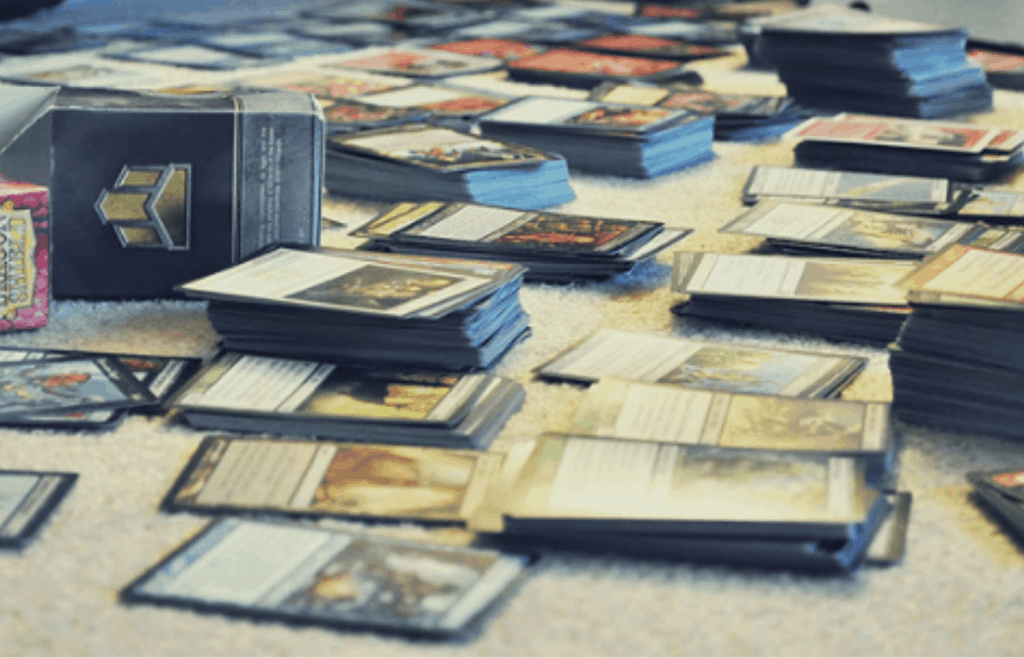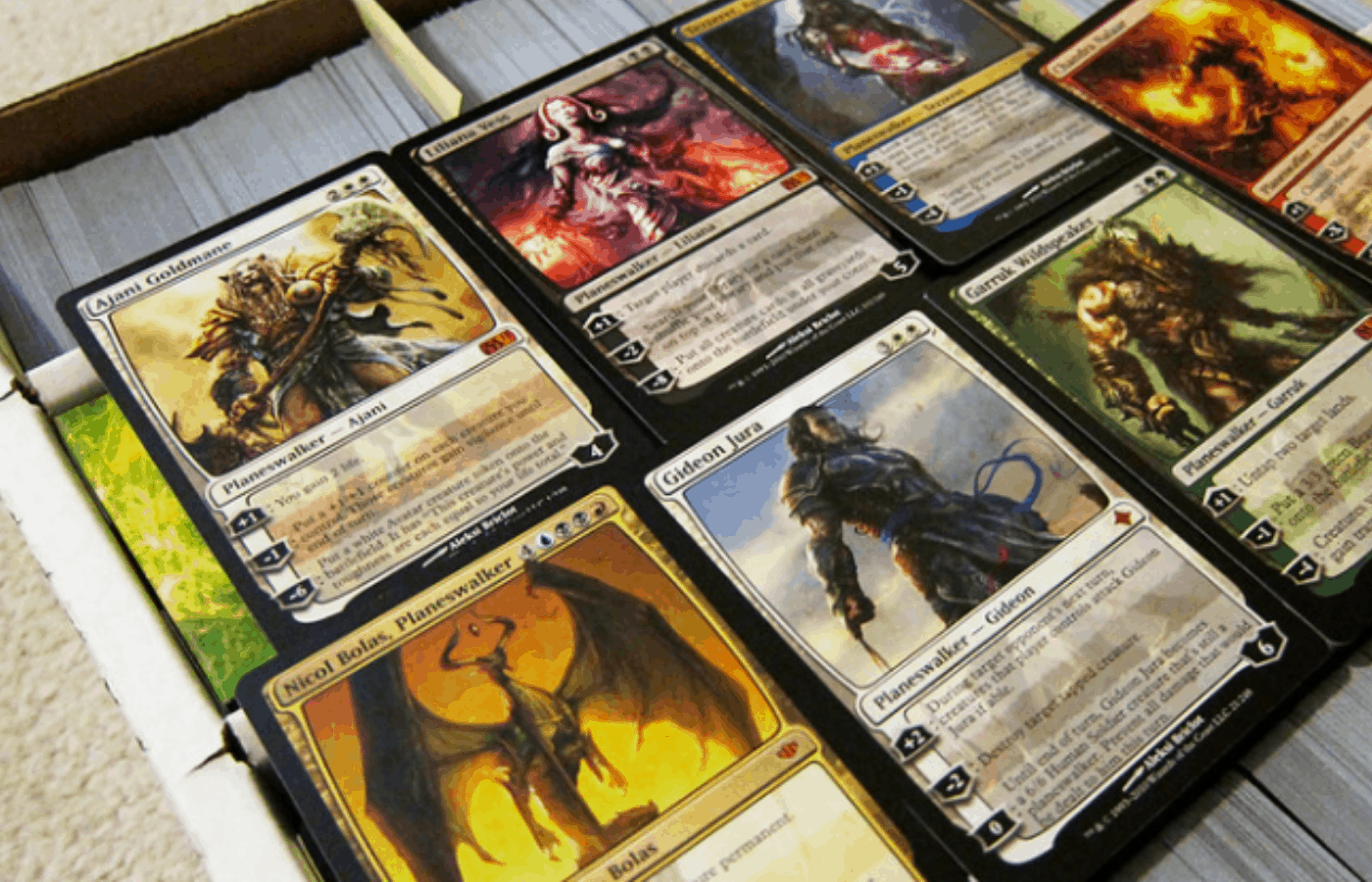Attend a few drafts or crack open a couple of booster boxes and it won’t be long before you have an unimaginably large collection of Magic the Gathering cards.
It’s ok though, it happens to the best of us, but its better to think about card storage early on in your journey before you have way too many cards to keep track of. Usually, the best way to store Magic the Gathering cards is by their usefulness in your collection.
This means using big card boxes for commons or non-valuable cards, card sleeves and card binders for rare and valuable cards, and having a separate binder for cards that are for selling or trading.
Storing Cards in Sleeves
This is the most common way to store Magic the Gathering cards. Sleeves are those little plastic wallets you put your cards in. You absolutely should never be playing with unsleeved cards. You are asking for them to be destroyed pretty quickly.
There are three main options on the market when it comes to card sleeves:
- Penny sleeves
- Standard card sleeves
- Toploaders
Penny sleeves, as the name suggests, cost about a penny each, unless you buy them in bulk. These are the best way to store MTG cards that have a small amount of value, but you aren’t playing with them. They are also a great way to ship cards out if you sell them.

Standard card sleeves come in a variety of flavors. They are more expensive than penny sleeves, but they are tougher. They have been built for regular card shuffling, and this means they offer your cards a superb amount of protection.
We recommend using these Ultra PRO Eclipse sleeves, from Amazon, for rare and valuable cards. They are great both for card storage as well as tournament play.
Toploaders are tough plastic cases. They are for storing the absolute best cards in your collection. You can’t play a game while your cards are in top loaders, though. It would make shuffling incredibly difficult. These cases are expensive and can run at 25c to 50c each, even at the lower end of the market.
Storing Cards in Binders
Binders are a good way to store cards that you like which you are not currently playing. If you are regularly attending FNM, then I suggest you have a trade binder of some sort. It makes showing off your collection and making those trades easier.
Try to stick with modern binders and use decent plastic wallets. Older binders will cause the front of the card to wear down. Poor quality plastic wallets will cause the cards to fall out, or at least bump from side to side in the wallet which will ruin the cards.
Storing Magic The Gathering Decks
If you have some decks, then we suggest that you get hold of some deck boxes and some card sleeves. Ultra-Pro versions of either should be fine, but just make sure that whatever you buy is decent!
Now, we know that you can get some 60-card deck boxes. For Magic the Gathering, we suggest that you steer clear of them. After all, if you are playing the game properly, then you should have a sideboard of 15 cards. You need to fit those into your deck box too.
In addition to this, it is likely that you will have some tokens, counters, and dice. A decent Ultra-Pro deck box will hold all of these.
The reason why we like to store decks separately is that we play with them a lot. It keeps the decks separate from the rest of our card collection, and it makes transport to and from Friday Night Magic a whole lot easier, which is always good!
All of our deck boxes are labeled with the exact deck that they have inside of them. It makes it a bit easier to sort through, although you don’t have to do that. There are many of you out there that may have just one or two decades.
Storing Magic the Gathering Cards in Bulk
How you store Magic the Gathering cards in bulk will be dependent on the cards.
Commons that you can’t really use in pauper and some uncommon draft chaff can just be stored in cardboard boxes. If you regularly buy the Magic the Gathering fat packs, then you have some awesome storage there already.
However, you can also pick up a Deckbuilder’s toolkit which will hold several hundred cards.

Most online trading card stores will also have larger unbranded cardboard boxes that you can use. These are great for when you start getting a collection of cards well into the thousands.
We recommend using these 800 count storage boxes by BCW from Amazon. They are an awesome way to store hundreds of cards at a time.
Expensive cards that you are not using, or cards that may have some value in the future, can be stored in penny sleeves or if you can afford it, real sleeves.
Of course, you will want to ensure that your bulk collection of cards is kept out of direct sunlight and in a cool, dry location. This will help to preserve the cards for as long as possible.
A Note on Draft Chaff
Magic the Gathering is a game designed for drafting. When Wizards of the Coast design their sets, they are designing them with drafting in mind. This means that many of the cards that you pull from a pack are for drafting purposes only. They will never work in a standard deck. This is what is known as ‘draft chaff’.
The more you draft, the more you will start to recognize which cards are draft chaff. These cards do not need to be stored in any way, really. If a card doesn’t work in a deck outside of drafts, then just store them in bulk. There is no need to spend extra cash on storage, is there?
Should You Give Bulk Cards Away?
This is up to you.
What you have to remember is that there are a lot of cards that are never going to have any real value in the game. It makes no sense to us for you to be storing them for long periods of time. They are just taking up space.
We like to give our draft chaff and some commons and uncommon cards away to new players in the game. While they won’t be competitive with the cards, it helps to free them up from our bulk collection, and it gives new players a decent starting point if they want to take their hobby forward, which is always going to be a good thing.
You may even want to tell them how they can incorporate these cards into their decks!
How to Organize Magic the Gathering Cards
Magic the Gathering is unique compared to other trading card games in the way that cards are printed, which means most common organizational techniques aren’t really used.

Let’s take Pokemon TCG, for instance. In the Pokemon TCG, each reprint of a card is pretty different (outside some trainers and energy cards). For example, a Pikachu that was printed in the base set has a different move set to one that was printed during the Sun ; Moon block. They are completely different cards.
Magic the Gathering is very different. Cards that have the same name are functionally similar. Take Giant Growth, Counterspell, or Dark Ritual. These cards are pretty much constantly reprinted in different sets, and thus they are staples. They are all exactly the same card.
A Dark Ritual printed in Limited Edition Alpha can be played in a set block that features Amonkhet cards.
Because of this, most people will not sort by set. Unless you are collecting sets and not playing games, your card collection would be all over the place and it would be dead tough to keep track of. As a result, we tend to suggest storing cards so that the same cards sit together, no matter the set.
How you organize the cards after this is up to you. At the very minimum, you should be storing cards based on color. Most MTG fans will store in White, Blue, Black, Red, Green. Then you can have the multi-color cards stored however you wish here.
You should also sort by card type. Look at the top of the card and it may tell you the card type (sometimes there will be two card types). This can include:
- Creature
- Land
- Artifact
- Enchantment
- Land
- Instant
- Sorcery
- Planeswalker
Sets tend to bring different card types to the table, so you may have to tinker with this a little bit.
On top of this, you can store by converted mana cost. So, the cards that cost 1 mana are stored together, and the cards that cost 6 mana will be together (while also being stored in color and card type). This makes deck building a whole lot easier.
While you may not store your cards in the same way, we tend to keep our playing sets and bulk cards separate. This means that our main collection contains a maximum of 4 of each card (outside of land cards) and the rest is bulk stored.
It makes things easier. After all, nobody really wants to be flicking through dozens and dozens of Giant Growths while deckbuilding, do they?
Other Storage Tips
We have one final tip for you, but you can choose to roll with this one or not.
This will require staying on top of your collection every few months, though.
Since we play a lot of Magic The Gathering, the cards that are legal in standard are kept separate. This makes it easier for us as it means we are not pulling out an awesome card and then realizing that it is a card that can’t be played in standard.
Outside of this, it doesn’t really matter all that much. Most people are going to have cards that are legal in modern, and if you play vintage then you will probably have a separate section for those too. The same with pauper cards.
Honestly, organize your cards based on what feels right for you. Make sure that you have access to the cards that you want to play at any one time.
Storing Cards for Sale
If you are planning on selling some singles, then we suggest that you throw most of this advice on its head.
We suggest that you actually arrange the cards by set and set number instead. It will make it a lot easier for you to find the exact card that you have sold.
If you can, try to store as many of the cards in penny sleeves as you can. Expensive cards should probably be stored in a top loader while ‘middle of the road’ cards in a standard card sleeve.
Final Thoughts
Collecting Magic the Gathering cards is no overnight task, but it can seem like overnight when you are flooded with hundreds of cards. It’s best to plan your strategy for card storage before you realize you have too many cards to keep track of.
Utilize card sleeves, card binders, and card boxes to help protect your cards from dust and damage. Then, figure out a way to organize them in a way that suits you best. Storing Magic the Gathering cards isn’t really that difficult.
In fact, the main issue that most of you are going to have is actually working out the order to store them in. Once you have cracked that, then storing them is dead simple. All you need are some basic supplies and you should be ‘good to go’.

